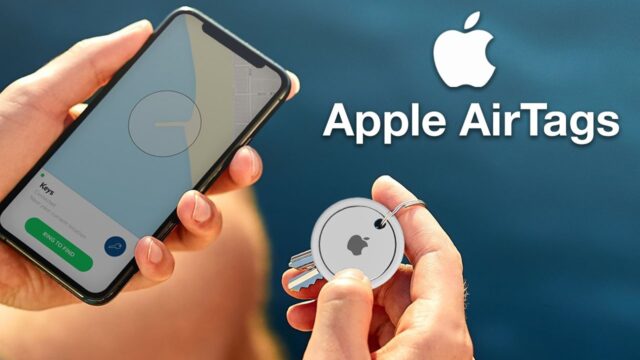As the title suggests, this is a review of the Apple AirTag, the company’s new Bluetooth low energy (BLE) device that can talk to iOS devices to provide direction-finding services. It’s an interesting idea, and I’m always interested in anything that can improve my ability to find myself in unfamiliar places. I have a few BLE-enabled gadgets and the service works fairly well, but I’m limited to the apps I’ve got installed on my phone and can’t use it for general directions. I was curious to see how good the AirTag could be.
What if you could find your lost keys or phone merely by putting on a pair of wireless headphones? That’s exactly what Apple has done with its new AirTag Bluetooth-based tag.
The Apple AirTagg has been a $35 accessory since the iPhone was introduced, but it’s only now that it’s available for Android smartphones. Most reviewers have praised the device for its simple and reliable precision-finding capabilities. But how precise is it? The AirTagg claims to be able to detect an object within a specific range of up to 10 meters. Is it accurate enough for everyday use in the real world? In this review, we explore how the device works, its accuracy claims, and whether it’s worth the investment.
(CNN) – After months of speculation and anticipation, Apple’s AirTag trackers are finally available at the relatively affordable price of $29 for a single AirTag or $99 for a package of four. We spent a week with five AirTags, which proved to be a very tough test. Overall, Apple’s integration of the beacons into the Find My Network provides an excellent coverage map, and the accuracy of their location is impressive. Combined with step-by-step directions to lost items, this is invaluable for Apple users who have lost their belongings. Be prepared to invest in a few accessories, as the AirTag cannot be connected directly to anything. To sum it up simply: If you are a member of the Apple ecosystem and want a device to track items, AirTag is the perfect solution. If you’re a member of the Apple ecosystem and looking for an easy way to keep track of just about everything, AirTag is for you. Read our full review and order today: https://cnn.it/3xEeoTs Posted by CNN Underscored on Friday, 30. April 2023. For whom? If you’re a member of the Apple ecosystem and looking for an easy way to keep track of just about everything, AirTag is for you. Android users should look elsewhere, and Tile Tracker is the place to start. What you need to know: After the initial installation, you will find that Airtag is integrated into Apple’s ecosystem and can be found in the Find My App. You can easily listen to the audio, get directions to the beacon, see the location on the map, and even mark the beacon as lost. Precision Finding, a turn-based control on iPhone 11 or newer, is a multi-faceted experience that helps you find lost items. Apple’s coverage map is truly unprecedented. As he compares himself: AirTag is not the first object tracker on the market, but for those in the Apple ecosystem, it has several advantages over the popular Tile tracker. It is easy to pair with your iPhone and much easier to use. The search accuracy is unmatched on Tile (or any other tracker on the market), and the coverage map updates faster in our tests. Apple’s Find My Network has about a billion devices, which is more than Tiles (millions), and offers a broader coverage map to find your stuff. You’ll have to make do with a design that doesn’t have a built-in key fob or adhesive strip, which means you’ll have to invest in accessories to get the full functionality of the device.  Jacob Krol/CNN This is the most interesting thing about AirTags: If you have an iPhone with a U1 chip in it (iPhone 11 or newer), your phone will give you step-by-step instructions for AirTag on the screen. With VoiceOver, a built-in accessibility feature, Siri reads directions aloud to help you find your way. Apple calls this Precision Finding, which uses a huge amount of technology to help you find your product again. It’s Bluetooth, U1, ARKit (Apple’s software framework for augmented reality, or AR), and your iPhone’s gyroscope and accelerometer working together. The distance in feet is displayed and an arrow appears on the screen to indicate the desired direction. This really changes the game and pushes this tracker much further than Tile. We often lose our keys, called Jacob’s keys, in Find mine. We ran around our room for about 15 minutes, but soon lost interest in running around. We launched the Find My application and chose Search for Jacob’s keys. The application then becomes a GPS that needs to find this object. You’ll see a slightly transparent screen that asks you to move around a bit, then it changes back to show the distance in the lower left corner. As you move around the room, the phone shows you an arrow and the direction – for example, 1 meter to the right or 1 meter behind you. However, when you approach an object, the app gives more accurate coordinates and tracks the distance to that object – and in our experience, it’s very accurate. You can also ping the AirTag with one touch, and in some cases you’ll be prompted to turn on your flashlight to get more light. It’s really like a personal GPS navigator to find your product. The secret ingredient here is the U1 chip, which enables ultra-wideband operation. It gives the iPhone a spatial view of the AirTag’s location and allows for a precise search. It’s a kind of personal GPS – no, not the one Michael Scott dropped into the lake, but the one that helps you find things again. And we tested it many times, both in the apartment, in the store (yes, we left the keys in a public place to test them), and in the house. In the latter case, we tested it on several floors, and although it took longer to find the object, the accurate search still came up with a solution. And the closer you get to the AirTag, the more accurate the tracking becomes. Same with the road – once you’re 20-30 yards away, you have directional signs. While we were testing AirTags, we also had a chance to fly. By placing an AirTag in our Away carry-on bag, we were able to track the bag from the time we left it until it passed through the airport. Fortunately, the device made it to the plane, and even in airplane mode on the iPhone 12, we could see the location update. A simple and effective way to turn an existing case into a smart case.
Jacob Krol/CNN This is the most interesting thing about AirTags: If you have an iPhone with a U1 chip in it (iPhone 11 or newer), your phone will give you step-by-step instructions for AirTag on the screen. With VoiceOver, a built-in accessibility feature, Siri reads directions aloud to help you find your way. Apple calls this Precision Finding, which uses a huge amount of technology to help you find your product again. It’s Bluetooth, U1, ARKit (Apple’s software framework for augmented reality, or AR), and your iPhone’s gyroscope and accelerometer working together. The distance in feet is displayed and an arrow appears on the screen to indicate the desired direction. This really changes the game and pushes this tracker much further than Tile. We often lose our keys, called Jacob’s keys, in Find mine. We ran around our room for about 15 minutes, but soon lost interest in running around. We launched the Find My application and chose Search for Jacob’s keys. The application then becomes a GPS that needs to find this object. You’ll see a slightly transparent screen that asks you to move around a bit, then it changes back to show the distance in the lower left corner. As you move around the room, the phone shows you an arrow and the direction – for example, 1 meter to the right or 1 meter behind you. However, when you approach an object, the app gives more accurate coordinates and tracks the distance to that object – and in our experience, it’s very accurate. You can also ping the AirTag with one touch, and in some cases you’ll be prompted to turn on your flashlight to get more light. It’s really like a personal GPS navigator to find your product. The secret ingredient here is the U1 chip, which enables ultra-wideband operation. It gives the iPhone a spatial view of the AirTag’s location and allows for a precise search. It’s a kind of personal GPS – no, not the one Michael Scott dropped into the lake, but the one that helps you find things again. And we tested it many times, both in the apartment, in the store (yes, we left the keys in a public place to test them), and in the house. In the latter case, we tested it on several floors, and although it took longer to find the object, the accurate search still came up with a solution. And the closer you get to the AirTag, the more accurate the tracking becomes. Same with the road – once you’re 20-30 yards away, you have directional signs. While we were testing AirTags, we also had a chance to fly. By placing an AirTag in our Away carry-on bag, we were able to track the bag from the time we left it until it passed through the airport. Fortunately, the device made it to the plane, and even in airplane mode on the iPhone 12, we could see the location update. A simple and effective way to turn an existing case into a smart case.  Jacob Krol/CNN Like the AirPods or the Apple Watch, the AirTag is designed as an iPhone accessory and installs in a minute or less. Just hold the AirTag near your iPhone and the configuration window will open automatically. Just give the tag a name and it syncs with your Apple ID. And, well, that’s about it. All AirTags are located in the Find My App app, and if you decide to use one of the AirTags in a different way, you can simply change the name. Apple offers several presets (such as key, backpack, or luggage), and you can enter your own presets. The AirTag is fairly unobtrusive: it’s a small disc with a white plastic side and a stainless steel side with the Apple logo. You’ll find some markings (like Bluetooth, U1, designed by Apple and assembled in China), but they’re pretty minimalist. It is smaller than a PopSocket, larger than a chessboard, and very convenient to carry in your pocket. The main thing we noticed after a week of using all five AirTags is that the stainless steel is slightly discolored – both on the shiny stainless steel and on the engraved Apple logo on the back. It’s like burning an iPod. Wiping with a cleaner like iCloth or a microfiber cloth can save some, but those scratches can go deeper into the surface and leave scratches. They only affect the appearance, the functionality is not lost. You can choose an emoji or a four-character engraving on the front at no extra cost. If you’re buying a four-pack for the family, this is a great way to keep the AirTags from getting mixed up. Emojis are a fun way to personalize it. There is a fair amount of technology involved. An accelerometer is present, as well as a U1 chip and Bluetooth. The connectivity is completed by the NFC (Near Field Communication) system and fulfils an important function. For example: What if someone finds a missing item and wants it back? Well, they can use AirTag with any NFC-enabled device that takes you to a website. And yes, this also applies to Android devices like the Galaxy S21. From there, they can contact the owner of the AirTag – but this only happens if you’ve marked the AirTag as lost in the Find My App app. You can provide the name and phone number of the person who found the AirTag. Of course, once you’ve found AirTag, you can disable loss mode and re-enable standard functions. Because the AirTag can also be used in hard-to-reach places, it is dust and waterproof according to IP67. This rating means that the unit can be submerged in water to a depth of one meter for 30 minutes. We’ve used it in the rain and submerged it in water a bit, and neither event was a problem. Apple promises a battery life of one year. It is easily detached from the back by pushing it down when it is time to replace it. Unlike other Apple products, this battery is replaceable. This is a standard CR2032 battery – you can probably buy one at your local store or pharmacy. You can also check the battery life of the AirTag (or AirTag) in the Find My application on your iPhone. But the design is the most questionable: it’s basically a small reader with no keychain opening or built-in adhesive. You will need an accessory to attach the AirTag to your key, backpack or luggage. Plus, it’s a little thick to fit in your wallet. And if you don’t want to buy accessories, you can put it in a pocket (hopefully a lockable pocket) of your backpack, luggage or jacket. However, there is no real free way to hang it from a key ring or attach it to your pocket.
Jacob Krol/CNN Like the AirPods or the Apple Watch, the AirTag is designed as an iPhone accessory and installs in a minute or less. Just hold the AirTag near your iPhone and the configuration window will open automatically. Just give the tag a name and it syncs with your Apple ID. And, well, that’s about it. All AirTags are located in the Find My App app, and if you decide to use one of the AirTags in a different way, you can simply change the name. Apple offers several presets (such as key, backpack, or luggage), and you can enter your own presets. The AirTag is fairly unobtrusive: it’s a small disc with a white plastic side and a stainless steel side with the Apple logo. You’ll find some markings (like Bluetooth, U1, designed by Apple and assembled in China), but they’re pretty minimalist. It is smaller than a PopSocket, larger than a chessboard, and very convenient to carry in your pocket. The main thing we noticed after a week of using all five AirTags is that the stainless steel is slightly discolored – both on the shiny stainless steel and on the engraved Apple logo on the back. It’s like burning an iPod. Wiping with a cleaner like iCloth or a microfiber cloth can save some, but those scratches can go deeper into the surface and leave scratches. They only affect the appearance, the functionality is not lost. You can choose an emoji or a four-character engraving on the front at no extra cost. If you’re buying a four-pack for the family, this is a great way to keep the AirTags from getting mixed up. Emojis are a fun way to personalize it. There is a fair amount of technology involved. An accelerometer is present, as well as a U1 chip and Bluetooth. The connectivity is completed by the NFC (Near Field Communication) system and fulfils an important function. For example: What if someone finds a missing item and wants it back? Well, they can use AirTag with any NFC-enabled device that takes you to a website. And yes, this also applies to Android devices like the Galaxy S21. From there, they can contact the owner of the AirTag – but this only happens if you’ve marked the AirTag as lost in the Find My App app. You can provide the name and phone number of the person who found the AirTag. Of course, once you’ve found AirTag, you can disable loss mode and re-enable standard functions. Because the AirTag can also be used in hard-to-reach places, it is dust and waterproof according to IP67. This rating means that the unit can be submerged in water to a depth of one meter for 30 minutes. We’ve used it in the rain and submerged it in water a bit, and neither event was a problem. Apple promises a battery life of one year. It is easily detached from the back by pushing it down when it is time to replace it. Unlike other Apple products, this battery is replaceable. This is a standard CR2032 battery – you can probably buy one at your local store or pharmacy. You can also check the battery life of the AirTag (or AirTag) in the Find My application on your iPhone. But the design is the most questionable: it’s basically a small reader with no keychain opening or built-in adhesive. You will need an accessory to attach the AirTag to your key, backpack or luggage. Plus, it’s a little thick to fit in your wallet. And if you don’t want to buy accessories, you can put it in a pocket (hopefully a lockable pocket) of your backpack, luggage or jacket. However, there is no real free way to hang it from a key ring or attach it to your pocket.  Jacob Krol/CNN The AirTag is pretty easy to carry, but you need an accessory to attach it to something. Sure, you can put it in your bag, but you have to make sure it stays there. Unlike some newer Tile trackers, there is no built-in adhesive or even room for a keychain. However, Apple also offers some accessories. This puts AirTag in a good position. We especially like the loops, which you can set yourself, so you can easily wrap it around a backpack or luggage strap. We bet that a classic polyurethane hinge will work for most people – and it’s cheaper. You insert the AirTag, close it and find a place to place a loop. We checked it on the backpack and hand luggage. The leather is of slightly higher quality, but offers the same functionality. A leather keychain is ideal for, you guessed it, a keychain. It is quite large though, with a large silver keychain that has a larger diameter than the AirTag itself. You can always remove it and just attach the leather part to the ring you already have on your keys. We haven’t tried it yet, but Belkin sells a slightly smaller keychain for just $12.95. Nomad Goods offers keychains made from the brand’s classic leather. The brand is even releasing an eyewear bracelet that we know will be useful for some users. Our full review of AirTags accessories can be found here. Apple even has an AirTag edition of Hermes. It costs $449, but it comes with an AirTag and a beautiful leather buckle from Hermès. This AirTag has its own design, in which the classic Hermes font has been used.
Jacob Krol/CNN The AirTag is pretty easy to carry, but you need an accessory to attach it to something. Sure, you can put it in your bag, but you have to make sure it stays there. Unlike some newer Tile trackers, there is no built-in adhesive or even room for a keychain. However, Apple also offers some accessories. This puts AirTag in a good position. We especially like the loops, which you can set yourself, so you can easily wrap it around a backpack or luggage strap. We bet that a classic polyurethane hinge will work for most people – and it’s cheaper. You insert the AirTag, close it and find a place to place a loop. We checked it on the backpack and hand luggage. The leather is of slightly higher quality, but offers the same functionality. A leather keychain is ideal for, you guessed it, a keychain. It is quite large though, with a large silver keychain that has a larger diameter than the AirTag itself. You can always remove it and just attach the leather part to the ring you already have on your keys. We haven’t tried it yet, but Belkin sells a slightly smaller keychain for just $12.95. Nomad Goods offers keychains made from the brand’s classic leather. The brand is even releasing an eyewear bracelet that we know will be useful for some users. Our full review of AirTags accessories can be found here. Apple even has an AirTag edition of Hermes. It costs $449, but it comes with an AirTag and a beautiful leather buckle from Hermès. This AirTag has its own design, in which the classic Hermes font has been used.  Jacob Krol/CNN Another special feature of AirTag is its integration into the Find My Network program. Yes, the same ones Apple users are used to using to recover lost laptops, phones, tablets, headsets and smartwatches. It is a network of nearly one billion Apple devices (iPhone, iPad, iPod Touch or Mac) that can receive Bluetooth signals broadcast by AirTag. When your AirTags are in motion, other devices pick up signals, so the location in the Find My app is updated regularly. This is a big advantage over other trackers that can’t be as accurate and don’t have as many features to keep the location known….. Or hide the features behind a premium subscription (we’re looking at you, Tile). As befits Apple, using AirTag is a private experience. Your AirTag data is anonymous and end-to-end encrypted, meaning that the location of your AirTag cannot be seen by others. Apple can’t even show the location. And although the AirTag sends Bluetooth signals to other Find My devices to locate locations, these signals are secure and often exchanged to ensure that the same signal is sent repeatedly. The privacy and Find My Network features are impressive, but in everyday use the AirTag is pretty similar to other object trackers. You will see the location as a dot on the map. If it communicates that it is in your home, you will probably be able to recognize it and activate the AirTag sound. This is a series of chirps that reflect well in a confined space. After several attempts, we were able to find our AirTag thanks to this phone call. This is not uncommon when tracking down items. The trackers from the Tile and Galaxy Smart Tag series show the location on a map with sound. With these two trackers, you can also press a button to make your phone ring. That’s something AirTag can’t do, although you can send a message to your iPhone from your Apple Watch. And because Apple’s tracker is integrated into the ecosystem, you don’t even have to open the Find My app on your phone. You can ask Siri on your HomePod or another device: Where are my keys? So that it starts playing the corresponding AirTag sounds. You can even ask Siri from the lock screen or home screen of your iPhone. It’s a perfect integration. Let’s look at a specific example that happened during our tests – we won’t say if it was intentional. Suppose you are walking through a park and your coat is marked with an AirTag. You stop for a moment on a bench, take off your coat and stand up. Without AirTag, you might be out of luck. But with this, all you have to do is launch the Find My app on your iPhone, and you can see his location on the screen, call him to chirp, and even figure out how to reach him. After a week of testing Apple’s tracker, it’s clear that it’s not the most revolutionary tech product of all time, even if the U1 chip does make a serious impression. But AirTag is very functional and practical. If you have an iPhone and are a member of the Apple ecosystem, they make a lot of sense. We’re all getting ready to go out into the world again, maybe even planning trips, and this is a really easy way to keep track of everything. Precision search literally changes the rules of searching for articles and allows you to spend less time searching. However, to use it, you must have an iPhone equipped with the U1 chip. These are the iPhone 11, 11 Pro, 11 Pro Max, 12 Mini, 12, 12 Pro or 12 Pro Max. The privacy of the Find My network is amazing compared to other trackers, and the end-to-end encryption ensures security. The Search my network is strong and covers a large area. We are very pleased with the AirTag and find it to be a great value. At $29 for a single pack or $99 for a four pack, you really can’t go wrong. If you are a member of the Apple ecosystem, AirTag is the tracker for you. We’d say the same for Android users or anyone looking for a tracker, but you’ll need an iPhone to set it up. The sticker tile or the classic matte are most convenient for those who use Android. This system is similar to AirTag except for its ability to perform accurate searches and integrate seamlessly. You can order an AirTag now for $29 or a four-pack for $99. Their delivery starts on the 30th. April.When I think about the future of technology, one of the first things I think about is Apple’s AirPods, the tiny wireless earbuds that are so easy to lose, so easy to use, and so easily misplaced. One of the main reasons I love these are because they are always with me, whether they are in my pocket, my bag or my ear.. Read more about apple airtag pret and let us know what you think.
Jacob Krol/CNN Another special feature of AirTag is its integration into the Find My Network program. Yes, the same ones Apple users are used to using to recover lost laptops, phones, tablets, headsets and smartwatches. It is a network of nearly one billion Apple devices (iPhone, iPad, iPod Touch or Mac) that can receive Bluetooth signals broadcast by AirTag. When your AirTags are in motion, other devices pick up signals, so the location in the Find My app is updated regularly. This is a big advantage over other trackers that can’t be as accurate and don’t have as many features to keep the location known….. Or hide the features behind a premium subscription (we’re looking at you, Tile). As befits Apple, using AirTag is a private experience. Your AirTag data is anonymous and end-to-end encrypted, meaning that the location of your AirTag cannot be seen by others. Apple can’t even show the location. And although the AirTag sends Bluetooth signals to other Find My devices to locate locations, these signals are secure and often exchanged to ensure that the same signal is sent repeatedly. The privacy and Find My Network features are impressive, but in everyday use the AirTag is pretty similar to other object trackers. You will see the location as a dot on the map. If it communicates that it is in your home, you will probably be able to recognize it and activate the AirTag sound. This is a series of chirps that reflect well in a confined space. After several attempts, we were able to find our AirTag thanks to this phone call. This is not uncommon when tracking down items. The trackers from the Tile and Galaxy Smart Tag series show the location on a map with sound. With these two trackers, you can also press a button to make your phone ring. That’s something AirTag can’t do, although you can send a message to your iPhone from your Apple Watch. And because Apple’s tracker is integrated into the ecosystem, you don’t even have to open the Find My app on your phone. You can ask Siri on your HomePod or another device: Where are my keys? So that it starts playing the corresponding AirTag sounds. You can even ask Siri from the lock screen or home screen of your iPhone. It’s a perfect integration. Let’s look at a specific example that happened during our tests – we won’t say if it was intentional. Suppose you are walking through a park and your coat is marked with an AirTag. You stop for a moment on a bench, take off your coat and stand up. Without AirTag, you might be out of luck. But with this, all you have to do is launch the Find My app on your iPhone, and you can see his location on the screen, call him to chirp, and even figure out how to reach him. After a week of testing Apple’s tracker, it’s clear that it’s not the most revolutionary tech product of all time, even if the U1 chip does make a serious impression. But AirTag is very functional and practical. If you have an iPhone and are a member of the Apple ecosystem, they make a lot of sense. We’re all getting ready to go out into the world again, maybe even planning trips, and this is a really easy way to keep track of everything. Precision search literally changes the rules of searching for articles and allows you to spend less time searching. However, to use it, you must have an iPhone equipped with the U1 chip. These are the iPhone 11, 11 Pro, 11 Pro Max, 12 Mini, 12, 12 Pro or 12 Pro Max. The privacy of the Find My network is amazing compared to other trackers, and the end-to-end encryption ensures security. The Search my network is strong and covers a large area. We are very pleased with the AirTag and find it to be a great value. At $29 for a single pack or $99 for a four pack, you really can’t go wrong. If you are a member of the Apple ecosystem, AirTag is the tracker for you. We’d say the same for Android users or anyone looking for a tracker, but you’ll need an iPhone to set it up. The sticker tile or the classic matte are most convenient for those who use Android. This system is similar to AirTag except for its ability to perform accurate searches and integrate seamlessly. You can order an AirTag now for $29 or a four-pack for $99. Their delivery starts on the 30th. April.When I think about the future of technology, one of the first things I think about is Apple’s AirPods, the tiny wireless earbuds that are so easy to lose, so easy to use, and so easily misplaced. One of the main reasons I love these are because they are always with me, whether they are in my pocket, my bag or my ear.. Read more about apple airtag pret and let us know what you think.
Frequently Asked Questions
How precise are Apple AirTags?
It’s easy to dismiss Apple’s AirPods as being the ultimate duds—after all, they only work near Apple devices, have an expensive price tag, and only last for a few hours on a full charge. But, I’m here to tell you: These are not just one-trick ponies—they have plenty to offer. And, with new features and a few tricks up their sleeves, they’re only going to get better. A few months ago, at the WWDC conference, Apple announced the new AirTags, which had all the features you could possibly want for a Bluetooth accessory. They’re more than just a basic hearing aid, though, being able to send a text message to the wearer whenever they are lost. However, as useful as AirTags can be when you’re lost, they might not be as reliable as advertised.
Is Apple AirTag worth buying?
If you’ve ever been lost or had to find your way home, you’ll know the value of a GPS. When software developer David Rusnak’s daughter was born two years ago, he got to thinking about ways to improve the infant’s life. His solution was to wirelessly track her using a GPS-enabled tag that would ping her location when it was docked in the baby’s backpack or stroller. The result is AirTag (formally known as TAGit), a computer-enabled tag that connects to a mobile device using Bluetooth, enabling parents to track their child’s location in real-time and even alert them with a message or a call if the device is lost or stolen. With AirPods now available to purchase, Apple has entered the wireless earbud market. AirPods are a somewhat strange product—they are both a true wireless earbud and a Bluetooth earpiece. They are also the first true wireless earbuds from Apple since AirPods were launched in 2016. If you buy them today, they will work great and be great for the time being, but what happens when they are upgraded and the new ones don’t work with the new iOS?
Are AirTags worth it without precision finding?
As an avid bushwhacker, I’m always amazed when I get lost, and that’s why I’m so excited to review AirTags, Apple’s new outdoor Bluetooth tracker. The AirTag is an accessory that can connect with your iPhone, iPad, or iPod touch through Bluetooth. The AirTag is designed to be placed in your pocket or pack, and it will track your movement and send alerts to your device when you leave or return to a preset location. If you are in the market for a new handheld GPS unit, it’s not often that a name like AirTrack stands out. Then again, GPS units are normally concerned with just one thing: getting you from Point A to Point B. However, if you’re interested in knowing where you might be, or need to know where you really are, this can be a real boon. This is the niche that AirTrack has set out to fill: with a set of tri-band GPS receivers, it can help you find your way around without any companion smartphone.







